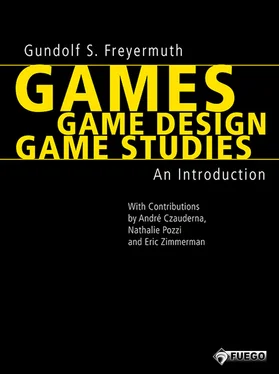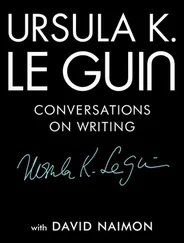1 ...8 9 10 12 13 14 ...17 PRIMARY, SECONDARY, AND TERTIARY MEDIALITY
Primary media do not require any technology. They “depend on bringing together special skills within a person.” 10In regard to communication media, Pross includes gestures and mimicry as well as pre-language and language-based sounds. Concerning forms of primary media that convey aesthetic experiences, he names rituals and ceremonies, among others. “The one thing they all have in common is the lack of an intermediate apparatus between the sender and receiver and that the human senses are sufficient for the production, transportation, and consumption of the message.” 11According to Pross’s criteria—even if he does not name them—pre-technical variants of the theater, such as improvisational theater and street theater, as well as games that function without technology, belong to primary media: for instance, movement games like TAG and HIDE-AND-SEEK or games of skill, such as ROCK, PAPER, SCISSORS.
Addressing secondary media, Pross writes: “The communicator requires an apparatus.” 12This refers to images such as drawings, paintings, caricatures, or photographs, also coins and paper money bills, as well as texts like letters, leaflets, flyers, books, newspapers, and magazines. Secondary media, of course, already existed for millennia before the Renaissance. In modern times, however, they received a three-fold push in their evolution:
1 In the textual realm: through book printing that allowed for standardized reproduction of texts in greater numbers for the first time;
2 In regard to the image: through the mathematically-based perspective technique, which led to a visual realism that was previously unattainable;
3 In terms of audiovisual representation: through the accumulation of numerous mechanical technologies employed in the creation of unprecedented theater structures, including sets painted and arranged in perspective, hoists and lifting platforms, curtains, and the perspectival-oriented seating arrangements for the manipulation of the audience’s gaze—the sum of which resulted in a new audiovisual realism.
As a modern complement to the church nave that was the central phantasmatic and public sacred space of the agrarian era, the theater and its proscenium or picture-frame stage advanced to become the central phantasmatic and public secular space of individual reflection, education, and self-understanding by the end of the mechanical era—a time characterized by gradual secularization. The new horizon opened up by the realistic audiovisual imitation of life turned the stage into the leading medium of the age:
“Drama, in a glittering succession of figures ranging from Shakespeare and Calderon to Racine, then dominated the literature of the West. It was the fashion to liken the world to a stage on which every man plays his part.” 13
At the same time games of secondary mediality—especially board and card games like CHESS or BLACKJACK—underwent a continual process of standardization, facilitated by the production of games through print and other mechanical means and the establishment of local, regional, national, and finally international distribution. The Industrial Age brought about the invention of numerous new games of secondary mediality as well—from the distinctly Prussian WAR GAME (1824) to the distinctly American MONOPOLY (1933) to DUNGEONS AND DRAGONS (1974). Although most of these new creations were identifiable as an expression of specific national (sub-)cultures, they nevertheless found massive, even intercultural, distribution.
Parallel to this, completely new tertiary media, in which “both the sender and receiver require apparatuses,” 14arose through industrial technology. Harry Pross names the electric telegraph as the first tertiary medium. It was followed by, among others, the telephone, the gramophone, animated and live action film, audio and video recording on magnetic tape. In particular, the industrial broadcast media radio and television changed how and what people played in a lasting way. Live transmission transformed sport and competition games of first and secondary mediality—like SOCCER and FOOTRACES, BLACKJACK and CHESS—from local events, in which participants and audience were physically present, into national and international events, which were passively experienced by millions. Furthermore broadcast media created a variety of new spectator games that were staged purely for radio and television.
Many of these radio and TV shows sought to involve not only studio guests directly, but also—through remedial media—a select few representatives of the ‘absent’ and passively situated radio and television audience. An especially interesting example was presented by the German game show DER GOLDENE SCHUSS (1964-1970), which was adapted for British TV as THE GOLDEN SHOT (1967-1975). Viewers of this show could call in to control and shoot an apparatus that consisted of a crossbow connected to a camera. This innovative combination of a new visual perspective and interactivity can be seen as an anticipation of experiences that would be delivered a few decades later by online first-person shooters. Through the transmission of sporting events as well as quiz and game shows, whose adaptation to the needs of radio and television transformed them from games of secondary mediality into ones of tertiary mediality, broadcast media created the largest shared experiences of industrial culture over several decades.
The medial difference between games can, thereby, be determined with respect to their mode of representation:
Games of primary mediality such as CATCH are based on a real simulation of reality;
Games of secondary mediality such as CHESS are based on a symbolic representation of reality;
Games of tertiary mediality, such as radio and television broadcasts of sporting events or quiz shows are based on a medial representation and adaptation of games of primary and secondary mediality, i.e., they allow for tele-audiovisual participation—mostly passive and remote—in edited simulations of reality as well as edited symbolic representations of reality.
The role of players and that of the audience differ radically across medialities: games of primary and secondary mediality allow players, as well as physically present observers, to engage in interactions that are partly self-determined and partly determined by others, whereas the proportional relation between audience and players remained relatively equal through the early 20th century. Games of tertiary mediality, on the other hand, do not only lead to an audience of millions watching a few players, they also subjugate the tiny minority of players to diverse medial regimes—from the selection of which sporting event to broadcast all the way to the live direction of several cameras and their perspectives through which every “real” game play is audiovisually fragmented and distorted.
CASE STUDY:
SOCCER—A GAME’S JOURNEY THROUGH MEDIALITIES
The historical process, in which individual forms of play accumulate numerous medial forms, can be demonstrated with the example of SOCCER, the “most universal cultural phenomenon in the world” 15and at the same time a central “sector of the global entertainment industry.” 16Estimates from the international soccer association FIFA say that at the start of the 21st century there were a billion active soccer players and 50 million referees, while the total length of white lines painted on soccer fields across the world could cover 25 million kilometers, “enough to circle the earth over a thousand times.” 17The beginnings of the game were less spectacular.
Pre-technical and largely unregulated variants can still be observed today when players kick around rocks or round fruit, such as apples, oranges, and melons. The game advanced from primary to secondary mediality around 4,000 years ago with the handcrafting of the first—still solid—balls from various materials, including leather and rubber, and the development of basic rules. 18However, the various ball games from Asia to Middle America emerged within the socio-cultural context of religious rites and warlike conflicts:
Читать дальше











